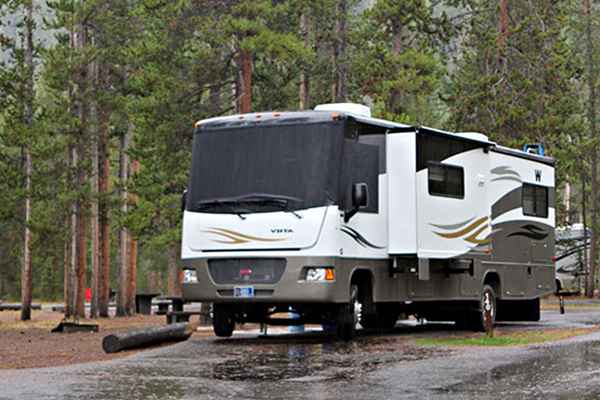
State and National Park RV Size Limit (Length Restrictions)
There’s nothing better than owning an RV — it gives you the freedom to go wherever you want without having to compromise on space and comfort. Therefore, it might be the perfect time to choose your home away from home. However, when choosing an RV, there are some things to consider, especially if you’re planning a tour in one of the national or state parks.
Namely, before you make a purchase, you should inform yourself about the US national parks RV restrictions and campground RV length restrictions. What’s more, if you already have an RV, this information will still prove useful — you don’t want to plan a trip only to find out you can’t camp out at your chosen destination because your RV exceeds the national park RV size limit. So what’s the max RV size for national parks?
What Size RV Is Allowed in National Parks
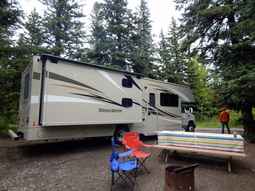
If you’ve gone with the attitude “the bigger, the better” when buying your RV, you might have to forgo trips to national parks. In fact, there are some quite notorious rules when it comes to national park trailer length limits.
As you know, your RV can be anywhere from 12 to 50 feet long. However, not all of them can fit into the guidelines that regulate the maximum trailer length for national parks.
Still, while having a small RV will make sure you can get practically anywhere, even if you aren’t ready to sacrifice your comfort for access rights, huge RVs can still get into around half of the national parks that allow RVs. Therefore, you might have to sacrifice the location of your camping, if you’re looking to buy a 41-foot beauty.
Best RV Size for National Parks
Generally speaking, the best RV lengths for national parks are between 12 and 25 feet. If your beauty is anywhere within this range, you’ll be able to get into pretty much any national park in the US. However, keep in mind that some parks don’t allow RVs at all and are “tent only.”
Almost all of US national parks RV size limits will allow a 12-foot, a 9-foot, and even a 25-foot RV on site. However, as the size of your camper increases, the chances of you getting onto a National Park camping grounds diminish.
Campground RV Age Limit
The US national parks RV restrictions sometimes also include age restrictions. Some campgrounds that are trying to maintain a luxurious look only allow new RVs on site. Therefore, you might see a sign that says that your RV isn’t eligible for a long-term stay if it’s older than ten or even five years. This is a real issue for enthusiasts who love old-time Airstreams, for example. However, this isn’t a problem that you’ll run into very frequently.
What’s more, since the campsites with age restrictions are a few and far between, if you run into this problem, you can always just move along. Another campsite is probably around the corner.
The Maximum Length of RVs in National Parks
The maximum trailer length for national parks varies from park to park. Some parks will even permit you access regardless of your RV size. Here are the US national parks RV size limits for the four biggest and the most frequently visited national parks.
Glacier National Park RV Size Limit
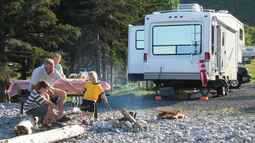
If you’re a proud owner of a massive RV and are headed for Glacier national park — you’re in luck. As long as your RV is 35 feet long or shorter, you’ll be granted the permission to enjoy most of their campsites. Still, it’s important to keep in mind that only seven out of thirteen Glacier campsites allow RVs at all.
This gem of pure Montana wilderness will be a perfect short-term home for your RV. However, not all seven campsites allow massive RVs. The Rising Sun campsite, for example, only allows RVs that are 25 feet long, while the Apgar campsite has above average campground RV length restrictions and will allow you to camp out in your 40-foot RV.
Yosemite National Park RV Length Limits
Arguably the most popular and the most famous national park, the Yosemite has ten campsites that accept RVs.Yosemite has a wide range when it comes to the maximum length of RV in national parks.
However, like many US national parks RV restrictions, the restrictions in Yosemite also usually differentiate between the RV size and the trailer size. Therefore, that’s something to keep an eye out for.
For example, in Yosemite Valley, you will be granted an entrance if your RV is not longer than 40 feet, provided that the trailer itself is no longer than 35 feet. On other campsites that accept RVs, the campground RV length restrictions are 35 feet for RVs and 24 feet for the trailer length.
Yellowstone RV Length Restrictions
Luckily for all us RV enthusiasts, Yellowstone, the first national park in the US, has 12 campsites, and they all allow RVs on site. However, only one campsite offers a place for massive RVs.
Fishing Bridge RV Park is a famous destination among RV owners. It allows a combined length of more than 40 feet when it comes to the RV and the towing vehicle. That means that you can easily get in with a 40-foot RV. The length of your towing car doesn’t count, as you can park it beside the trailer (instead of parking it in front of the trailer).
However, other campsites have a different set of campground RV length restrictions — the maximum length is 40 feet, but that includes both the length of the RV and the length of your towing vehicle.
Zion National Park RV Length Limits
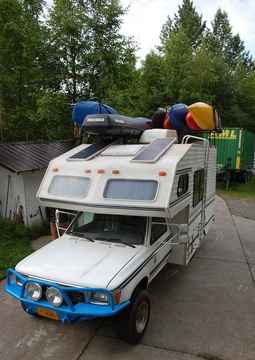
If you have your heart set out for the national park Zion and you own a large RV, you won’t be happy with the size guidelines. Namely, the maximum length of an RV in national parks such as Zion is around 19 feet. Furthermore, all campsites allow a maximum of two vehicles — your towing vehicle and your trailer or RV.
Do you plan on heading to the Grand Canyon or the Bryce Canyon after your trip to the Zion national park? If your vehicle is large, then you’ll need to obtain a special tunnel permit. Namely, you need a tunnel permit if your vehicle is wider than 7 feet, 10 inches and taller than 11 feet, 4 inches. What’s more, if your RV is longer than 40 feet or the combined length of your vehicle and trailer is longer than 50 feet, you won’t be granted access to the Zion-Mount Carmel Tunnel.
Maximum RV Length at State Parks
There isn’t much of a difference in maximum RV length allowed when it comes to national and state parks. What’s more, state park RV length restrictions also vary from park to park. That means that you can find a suitable location no matter what your RV length is.
Texas State Parks RV Length Limits
The Lone Star state has many state parks, many of which allow RVs on their campsites. However, if you own a huge RV, there’s a good chance that you won’t be granted access to a great number of them.
Therefore, keep in mind your RV length while planning your trip. If you are headed for the Texan fan-favorite, Radcliff Lake Park, or to Oakland Park, you might not have any problems finding a suitable campsite. You can enter these parks even with a monster RV of a combined length of 50 feet. However, parks like the Jackson Creek Park only allow RVs up to 25 feet in length.
Maximum RV Length — Oregon State Parks
Oregon state parks have an average, general rule that the combined length of your towing vehicle and your RV can’t be over 40 feet. That means that most RVs that are over 30 feet aren’t allowed.
However, that’s not the case at all campsites. Still, if you have a 35-foot RV, you might have trouble finding the space. However, some parks and campsites allow you to unhook your RV from your vehicle. That way, you can park the vehicle besides the RV. That might be a way around this rule.
It’s important to note that Oregon state parks and their campsites have a very wide range of state park RV length restrictions. On some campsites, the maximum length goes up to 80 feet. For example, the regulations aren’t so laid back in California as they are in Oregon.
California State Park RV Length Limits
California state parks allow for 25–30 feet long RVs, on average. Most campsites were originally designed for tent camping. Therefore, they don’t have enough room to accommodate huge RVs and their towing vehicles.
However, in California state parks, much like in Oregon, the campsites have regulations about RV sizes that vary. So, for example, the D. L. Bliss State Park and the Tahoe state park only allow RVs that are a maximum of 18 feet long (15 feet long trailers).
On the other hand, if you have a large RV, you still have options in California. Bolsa Chica State Beach allows trailers up to 40 feet long. Meanwhile, Emma Wood State Beach allows RVs as long as 45 feet.
Florida State Park RV Length Restrictions
Florida is a very camping-friendly state. Therefore, a lot of state parks allow RVs, and many of them will accommodate your large RV. Campsites in Florida also have a wide range of state park RV length restrictions. Some of them only allow vehicles that are 10 feet long. However, others allow massive rigs of 104 feet in length.
In fact, in Florida, the motto is — the bigger, the better. At least when it comes to the RVs. Thirty state parks allow RVs that are over 45 feet long. Meanwhile, twelve parks allow rigs that are between 36 and 40 feet long. Only four parks allow for vehicles up to 35 feet in length.
Washington State Park RV Length Restrictions
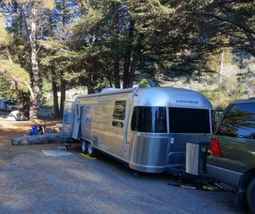
Washington is a gorgeous state to camp in. In fact, you can choose one of almost 50 state parks to set your rig in. However, not all of them have the same state park RV length restrictions. The average size limit in the state of Washington is between 30 and 35 feet. However, you can find campsites that allow RVs up to 60 feet in length.
What’s more, if you have a genuinely huge RV, you can explore the option of private campgrounds. They are not that rare, and most of them have size limits that allow for bigger RVs. In fact, most of them allow the length of 60 feet or more per RV.
A Few Parting Words
US national parks RV restrictions vary greatly. Therefore, if you are looking to buy an RV, make sure you include these restrictions as a deciding factor. However, if you already own an RV, this information might help you plan your next adventure. It’s crucial to know if you can camp out at a certain park or not.
Things aren’t much different when it comes to state parks as well. It seems that Florida is the most camping-friendly state. However, you should definitely check national park trailer length limits and state park RV length restrictions no matter where you plan on setting up camp next.

